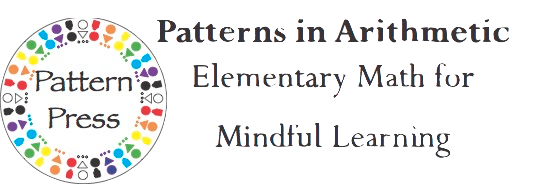It is essential that learners build models of problems, draw pictures to prove their own answers, show understanding, and communicate their ideas to others. This program adopts the following conventions. The first number of an equation tells the amount or number of blocks to start with. The second number is seen as part of the operator, with the sign, and tells what to do next. The order of the words and the action of the hands correspond. Each operation–addition, subtraction, multiplication, and division–uses the same convention throughout the entire Patterns in Arithmetic series, Books 1 and 2 and Booklets.
4 + 2 = ? means start with
four and add two more.

4 - 2 = ? means start with four
and take away two.

4 x 2 = ? means start with four
and add it two times (4 + 4 = 8).

4 ÷ 2 = ? means start with four
and divide it into groups of two
(or make two groups).

Make Your Own
Make your own problems should be done routinely. The student acting as a mathematician invents problems, which strengthens her control over the learning process. This reveals to the teacher her understanding of the concepts, how her mind works, and her current level of competency and confidence. It is a creative act for an empowered learner, and through its use powerful habits of mind will grow.
Time Span
Time span is a general guide for how long a lesson may take or the length of a practice phase. Since each individual will vary in her pace based upon age and experience, do not worry about externally suggested time frames or compare one student to another. The time spans given are for an average student at the third-grade level (about eight years old). Adults who are teaching themselves will pace themselves by their understanding, ease, and fluency with each concept.
At the Farm School students invented unique, successful ways to solve problems and discovered that although the standard regrouping algorithm has particular advantages in a base ten system, it is only one way among many. This invention laid a foundation for understanding all arithmetic algorithms (addition or subtraction or multiplication or division) because they are all built on the same model, a process with three parts: decomposing a large problem into many small problems, solving each small problem, and adding the results. When students understand this, each new arithmetic procedure has a familiar feeling, because it is seen to be part of the same family of algorithms.
The idea of breaking up difficult problems into smaller ones and then solving the little problems first can be applied to all of life. For example, a difficult piece of music is broken up into smaller parts to be practiced separately, then played all together later. And specifically to Patterns in Arithmetic a large third-, fourth-, and fifth-grade set of arithmetic lessons is broken up in a different way: by operations and by fractions and then recombined in booklet form for learners of all ages to do in their own chosen order.
The philosophy of the Farm School is based on the insights, ideas, and teachings of Professor Michael Butler. Over the years the work of many teachers has resulted in a mathematics program that aims to teach students to think like mathematicians.
"Anything children learn from adults can be learned more readily from another child."
Welcome to this learning adventure.
